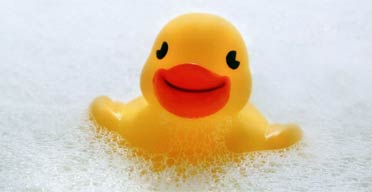
Photograph: Benjamin Rondel/Corbis Photograph: Benjamin Rondel/Corbis
Once upon a time, the housewife's cleaning armoury consisted of several trusty household faithfuls, which could be relied upon for a whole host of domestic chores. There was vinegar to clean windows and polish, baking soda for stains and smells, lemon juice as bleach and cleaner. Meanwhile, the dressing table and bathroom were home to a few basic essentials: cold cream, soap and soda crystals for the bath, with perhaps a small bottle of eau de toilette for special occasions.
These days cleaning products and cosmetics are billion pound markets. A peek under the sink and inside the bathroom cabinet reveals a dizzying array of products, each designed with an ever-more specific job in mind - and a high price tag. But while the expense may be growing, the main cause for concern is the potential toll on our health and environment of using and flushing away so many industrial chemicals.
Unlike the simpler supplies of our grandparents' era, the products we use today are overwhelmingly developed and tested in laboratories from a complex mixture of artificially synthesised chemical compounds - the 'science bit' the advertisers try to impress us with. Some of these compounds are toxic if ingested and present a particular risk to children. Of course, the use of these chemicals is regulated, but with many of the long-term consequences of using them as yet unknown, plenty of shoppers are starting to opt for organic or natural alternatives.
The other inescapable issue is environmental - the chemicals flushed down our sinks pollute rivers, lakes, canals and coastal waters and can cause serious harm to freshwater and marine life. Many of the chemicals we routinely use at home are both persistent and bioaccumalative - in other words they take a very long time to break down in the environment and can build up in living tissue in both humans and animals.
The impact of over 20m households disposing of so many products is enormous. By replacing some of your shop-bought cleaners and cosmetics with homemade, non-chemical versions, you'll be doing your bit to help make the waterways cleaner and safer for everyone.
And there's a third issue - packaging. The Environment Agency estimates that British households throw away more than 88,000 tonnes of packaging waste every week, with landfill sites running out of space as a result. Making your own products means you can reuse cosmetics bottles and jars you already have, as well as finding a new life for old jam jars, or wine and olive oil bottles.
So there you have it - revamping yourself as a homemade homemaker is good for your pocket, minimises your risk of exposure to potentially harmful chemicals, and is kinder to the environment.
Over the coming months we'll be returning with ideas for lots of homemade products you can try out for yourself, and of course if you've got any great recipes you'd like to share with us, please do email them in.
Bubble bath
You can make your own bubble bath using just four basic ingredients: distilled water, liquid glycerin, castile soap and essential oils.
· Distilled water is water that has had all the chlorine, minerals and other impurities removed. You can buy it from health food suppliers or car mechanics (it's used in car batteries!).
· Glycerin is a natural by-product of soap manufacturing which is usually removed from commercial soaps but adds moisture and helps create bubbles. It can be purchased from chemists (try a local family run chemist as they're more likely to be familiar with 'traditional' products like this) or online.
· Castile soap is a traditional form of soap made from vegetable oils rather than animal fats, traditionally olive oil, though other oils such as coconut, almond, hemp, and jojoba can also be used. The Sheer Bliss Natural Soap company in Dover has a range of castile coaps that have already been infused with essential oils or you could go for a bottle of unscented liquid castile soap from Dr Bonner .
· Finally the essential oils - widely available from health food and beauty stores as well as online - are used to add scent to your bubble bath.
Note: as they do not contain chemical preservatives, these bubble baths may not last as long as their commercial counterparts.
The following recipes are courtesy of Abigail Beal, a freelance writer and crafter from New York (measurements have been converted to metric).
Sweet dreams bubble bath
6 drops of lavender oil
3 drops of patchouli oil
1 litre of distilled water
1 bar of castille soap, grated (or 100ml liquid soap)
100 ml liquid glycerin
Directions: mix the water, soap and glycerin together and stir. Then add the essential oils.
Cold season bubble bath
This bubble bath will help you breathe easier, with eucalyptus oil to ease congestion.
6 drops of eucalyptus oil
3 drops of spearmint oil
3 drops of peppermint oil
1 litre of distilled water
1 bar of castille soap, grated (or 100ml liquid soap)
100 ml liquid glycerin
Directions: mix the water, soap and glycerin together and stir. Then add the essential oils.
Pure sunshine bubble bath
This citrusy bubble bath will cheer you up and energize you. Perfect for a morning bath or use after exercising.
6 drops of orange oil
4 drops of grapefruit oil
3 drops of lemon oil
1 litre of distilled water
1 bar of castille soap, grated (or 100ml liquid soap)
100 ml liquid glycerin
Directions: mix the water, soap and glycerin together and stir. Then add the essential oils.
Love potion bubble bath
6 drops jasmine oil
3 drops rose oil
3 drops vanilla oil
6 drops ylang ylang oil
1 litre of distilled water
1 bar of castille soap, grated (or 100ml liquid soap)
100 ml liquid glycerin
Directions: mix the water, soap and glycerin together and stir. Then add the essential oils.

